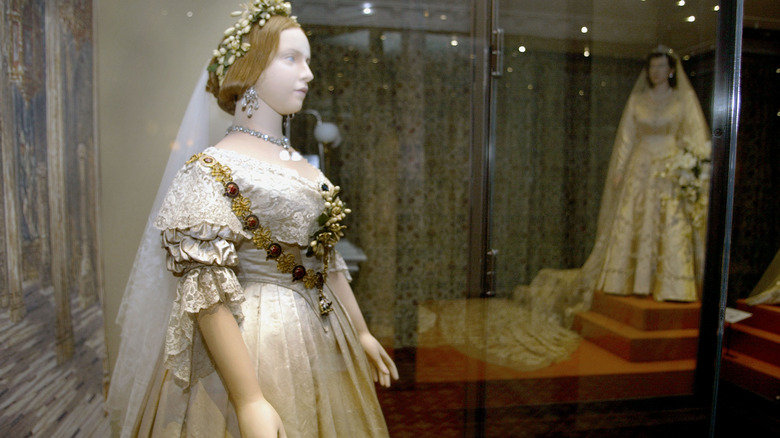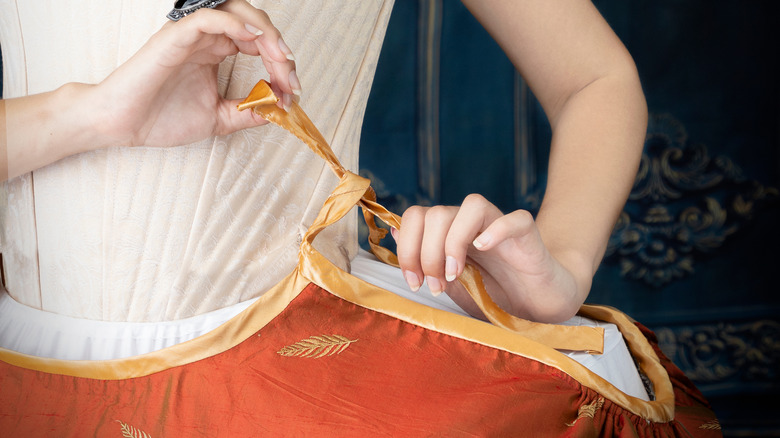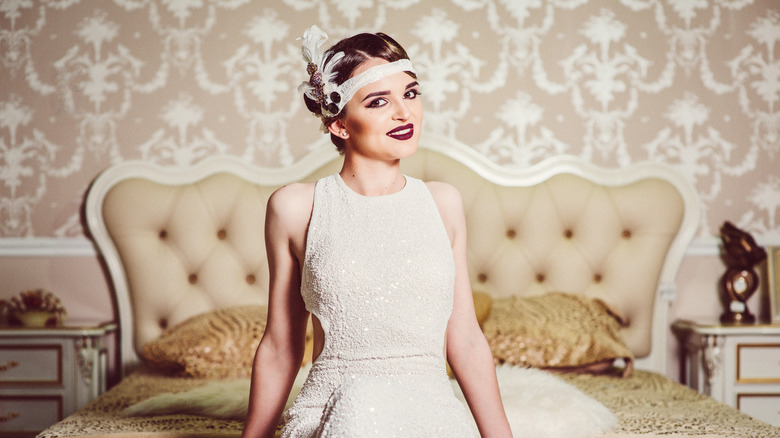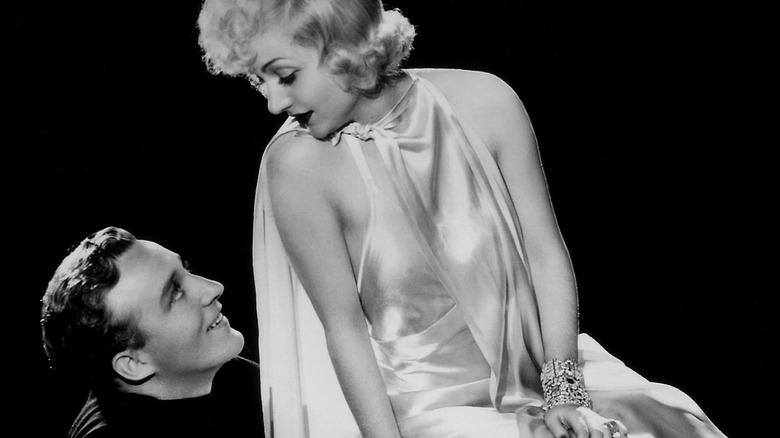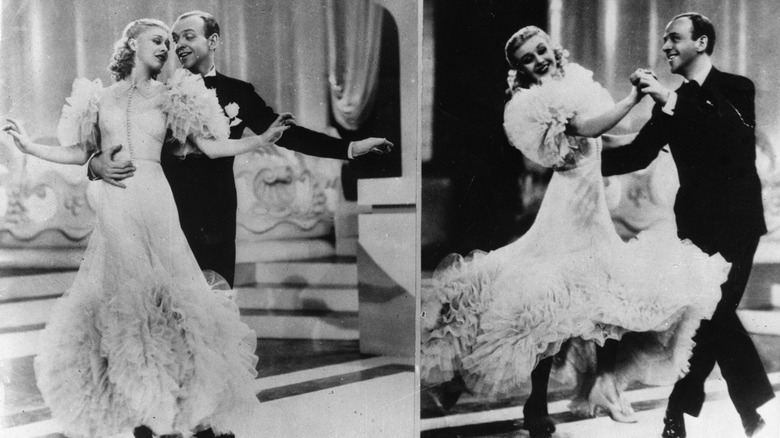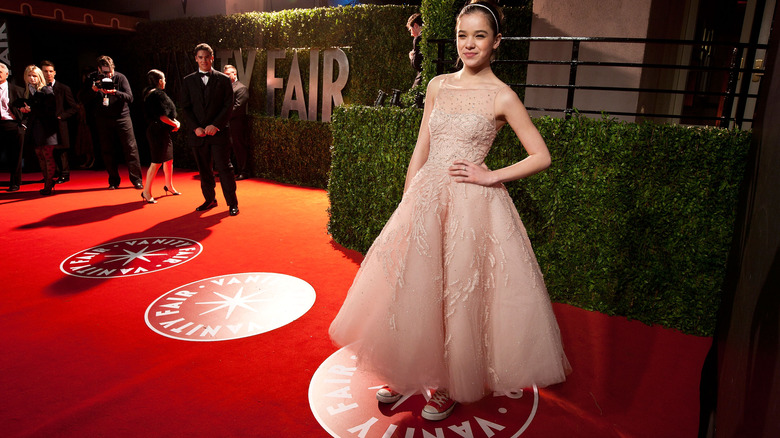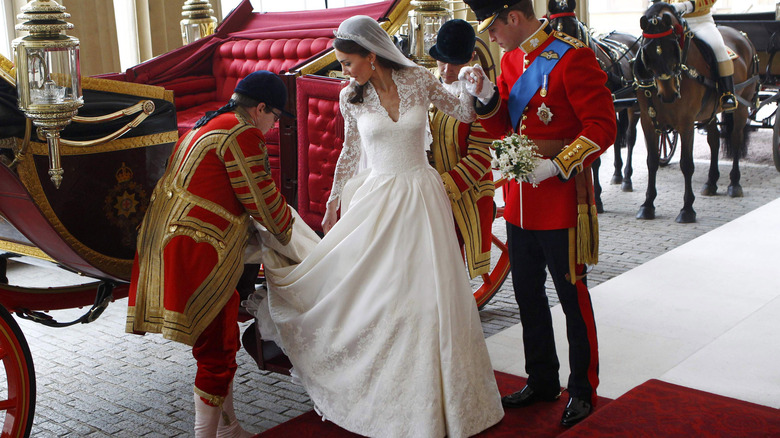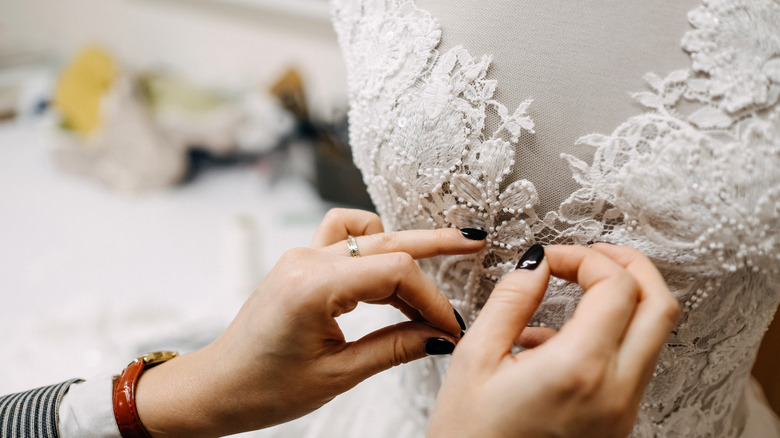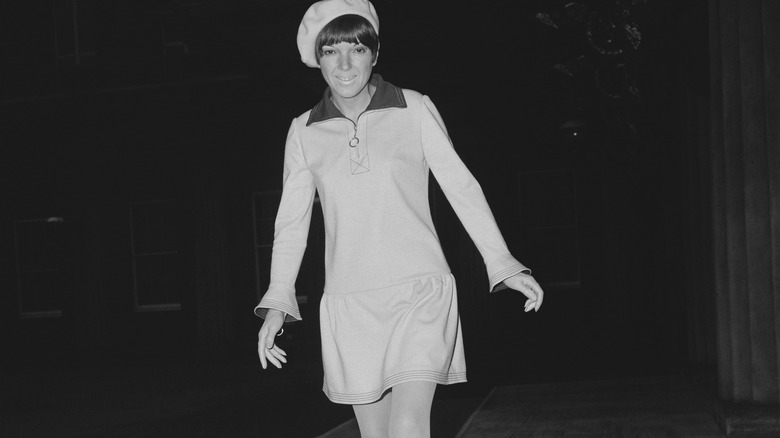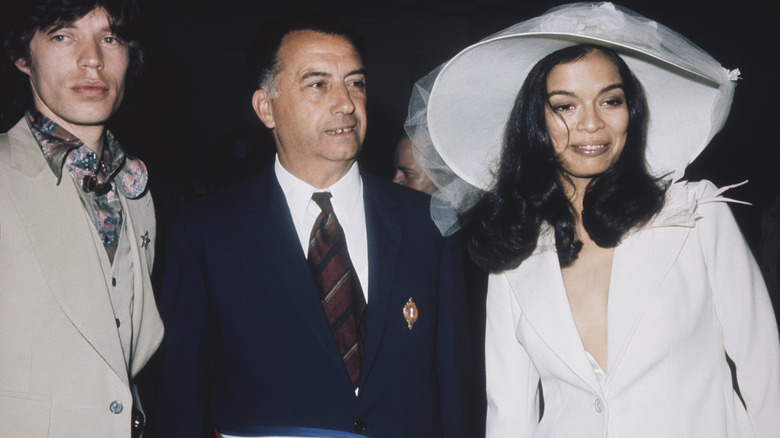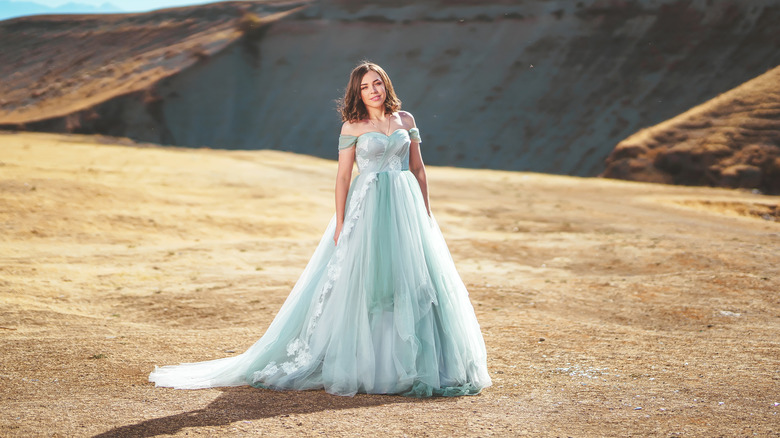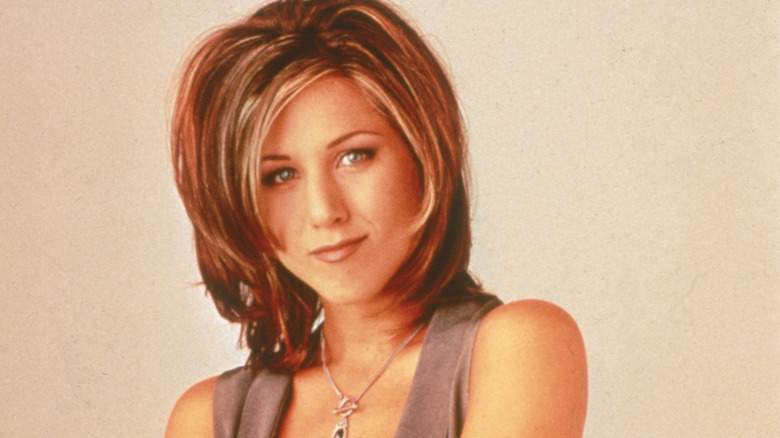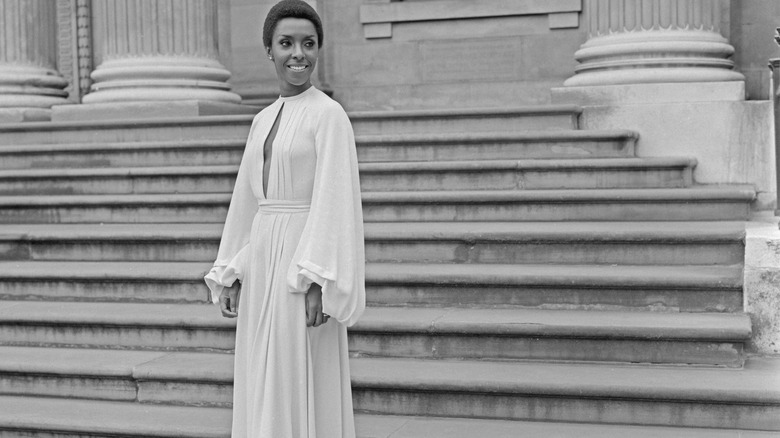Vintage Wedding Dress Styles That Need To Make A Comeback
The idea of a designated gown solely worn on a wedding day is relatively recent. In the past, that distinction was reserved only for members of the royalty — the everyday bride was likely to wear her best dress. Weddings were not extravagant parties; merely small ceremonies with a few witnesses and perhaps a dinner afterward. In general, white was not worn, reports author and journalist Summer Brennan (via JSTOR Daily). It was challenging to keep clean, even for royalty. They preferred robes of regal colors like gold or blue, even for their wedding gowns.
Princess Philippa of England wore the first white wedding dress recorded in Western culture in 1406. Her tunic was white-lined with fur. Occasionally, royals over the years would follow suit, but it wasn't until Queen Victoria married for love in 1840 in a white gown and veil that the trend took hold. Coincidentally, every bride expected to wear her wedding dress again, even Queen Victoria. Brennan claims it wasn't until the Industrial Revolution and the advent of photographers and fashion magazines that the idea of a wedding dress being only a wedding dress was born.
With that in mind, there are quite a few vintage and historical bridal styles we'd like to see worn again, on the runways, down the aisles, and maybe even more than once!
Panniers
Typically seen on eighteenth-century women, these handy little hip baskets ( a la "Outlander") are making a comeback on the runways. According to History Daily, the bold style was originally inspired by Spanish court dress of the 17th century. "The fashion became popular in France and, after c. 1718–1719, it to the rest of Europe when some Spanish dresses had been displayed in Paris. Some say the pannier originated in Germany or England, since it has been around since 1710 in England, and even appeared in the French court in the last years of Louis XIV's reign," the outlet reported.
In recent years, designers like Christian Dior, Jean Paul Gautier, and Moschino have featured these iconic accessories in their fashion lines. Designer Rick Owens, who sported them in his 2018 collection, is quoted by Medium as saying, "It's been awhile since this kind of deliberately sly exaggeration was embraced."
We think it's time to embrace the pannier. Consider the amount of space they can take up. When a bride enters the room, there is no easier way to clear the area around them than with a dress that literally moves the crowd out of the way. They can be worn around the hip, like Marie Antoinette wore them, or closer to the bottom of the dress, as was done in the 1920s. Any bride who sports them can claim elegance and as much space as they wish.
The 1920s drop-waist style
You may not have Leonardo DiCaprio to smile over your upcoming nuptials, but you definitely can't go wrong with a drop-waist "Great Gatsby" flapper-style dress for your bridal ensemble. The 1920s era inspired all sorts of beading, layers, frills, and lace. The fashion experts at Stitch Fix describe how to wear this vintage trend on a modern bride. "We love this style in a mini length, which modernizes it a bit. The key to pulling off a drop-waist dress is making sure that it doesn't hug you anywhere. It looks best when it hangs freely. This style looks amazing on athletic, lean, and boxy shapes who don't have much curve throughout the hip."
If the dress style isn't your cup of bubbly, you can adopt some of the accessories from the era. Consider long pearls, tiny handbags, and statement headbands. A pouty red lip with a modern take on a wavy bob will complete the 1920s look and keep you partying well into the night.
Go Hollywood glam
If you aren't into the flapper era of the 1920s, feel free to jump one decade ahead to the Hollywood glamor era of the 1930s. During the Great Depression, Americans looked to the big screen for escape and for their fashion inspiration. Bridal jewelry designer Tyler Wilson confirms, "One vintage style that I hope makes a comeback is the glamorous Hollywood-inspired 1930s look. I'm talking about simple yet elegant satin gowns that are figure-hugging and show off the bride's curves in all the right ways. These dresses always make me think of old black-and-white movies. They look elegant and chic. It is the classic Old Hollywood glamor at its best."
Clean lines, cowl necks, simple fabrics (not a lot of lace), and rayon were standard in the 1930s. Hollywood starlets were like art deco in a dress. Add an elegant brooch or vintage belt to your bridal attire, and you can become Hollywood glam personified.
Gowns with feathers
Speaking of the 1930s, some of the most iconic dresses of the age were feathery conventions. While they were lacking in lace due to war austerity measures, they made up for it in layers of tulle or gowns that dripped in feathers. The same look is possible now in wedding attire, with a modern twist. Fashion expert at Best in Edmonton Brian Jones says, "For ladies who have always imagined wearing a whimsical gown on their wedding day, wedding gowns with feathers are ideal. Wedding gowns with feathers are imaginative and gorgeous, regardless of whether you're organizing a big event or want to elope. A vintage-inspired feather wedding dress is made to resemble recognizable silhouettes and fashions from a certain era."
As Lean Davis, co-founder of bridal boutique Cicinia claims, "The wedding ideas from the past are unique and classic. [Vintage bridal-wear] shouts elegance and class." This style will look incredible on the dance floor and keep you swaying all night.
Tea-length dresses and elegant gloves
If long skirts get you all tangled up, perhaps a tea-length dress is the way to bring elegant timelessness to your wedding day without making an inelegant entrance down the aisle. Fashion expert Brian Jones names this as his top pick for bridal vintage fashion. "This wedding dress shape is longer than cocktail dresses and mini dresses and stops mid-calf, about six inches above the ankles. Shorter hemlines have long been the go-to for elopements, civil weddings, or brides who simply don't want the fuss of a floor-length gown. Tea-length wedding dresses are retro and playful, and flattering for curvy and petite brides alike."
Bridal expert Lean Davis would love to see the return of an elegant glove to complete the retro feel of the look. "[You] could use short, long, or even fingerless gloves, as long as it compliments the wedding gown. It could make you look chic, elegant, and cute at the same time ... [Gloves] still showcase simplicity and femininity."
Royal-inspired ball gowns
According to Caitlin Parish, CEO of an online bridal boutique, "Another crowd favorite is the nipped waist and full skirt wedding dress with long and short lengths inspired by the bridal fashion of the 1950s and1960s." This largely resembles the royal weddings that were such crowd-pleasers. The wedding of Queen Elizabeth to Prince Phillip in the late 1940s began the trend. The dress was designed by Norman Hartnell and was made entirely of satin.
A few years later, when actress Grace Kelly married her real live Prince Ranier III of Monaco, she wore a similar dress designed by the wardrobe department at Metro-Goldwyn-Mayer (via Philadelphia Museum of Art). It featured a similar nipped waist and large bell skirt that gave the bride a regal shape. The bride included a lace bodice that wouldn't have been available to the queen during her wedding so near war-time. Her dress was donated to the Philadelphia Museum of Art shortly after the wedding and, according to the curators, "Continues to serve as the ultimate exemplar of bridal elegance."
Thus far, royal weddings in the public eye have continued to follow this ball gown tradition, including the dresses of Kate Middleton, Princess Diana, and Sarah Ferguson.
Lace with a side of elegance
During the Great Depression and World War II, Brides.com reminds us that "Fine French lace was also a thing of the past, and instead, brides wore cotton, crochet-esque weave during this time period. But once these more austere decades ended, lace made its gallant return to the bridal ensemble.
As bridal boutique owner Caitlin Parish says, "I think that lace is a particularly beautiful fabric for vintage wedding dresses. I love the look of an all-lace dress or a dress with lace accents. The lace adds a lot of romance and elegance to a wedding dress... I believe lace wedding dresses should be seen more in today's boutiques." Parish's counterpart and CEO, Josephine Li, agrees, "I'd prefer to revert to wearing dresses with lace accents or shorter veils like we've done in the past. These styles are classic but still give an elegant aura to the bride. Stylists should use these designs again and showcase to their clients that the styles before can still be revived today and stand out."
The editors of Wedding Forward concur and add, "Vintage style lace wedding dresses gently flatter and emphasize the feminine curves, bestowing a classic look on the bride. We love when they are dainty yet dreamy, sleek, and romantic with negative space details. If you love something glamorous with layered beadwork and pearls, decorative stones, embroidery, bugles, choose lace."
1960s mini-style
And for something completely different but still vintage, consider the short, geometric dress of the 1960s. Bridal jewelry designer Tyler Wilson says, "The 1960s: a revolutionary time that saw the rise of mini skirts and bold geometric prints. I love how fashion in the 1960s was all about having fun and being experimental, something we could use a little more in our lives today. For example, wedding dresses in the 1960s were usually shorter and paired with tights. An example was Audrey Hepburn's Givenchy dress."
Canadian fashion designer Michael Kaye says, "This is when our waistlines move higher up, or sometimes there's no waistline at all. There were [also] metallic and floral embellishments. Daisies were the popular embellishments of choice, the flower child, 'all we need is love' types."
Inspired by the classic elegance of Jackie Kennedy, the simple sheath dress with a boatneck collar and, yes, a shorter skirt, would make the perfect elopement outfit. Or, wear a short mini-dress for the reception or for leaving the wedding party. There are many ways to rock the mini-look and keep it bridal. Add a hat, veil, gloves, or even some pearls in the hairstyle to complete the picture.
Power suits and commanding hats
Moving forward into the 1970s, perhaps mimicking Bianca Jagger's classic wedding suit is a perfect choice. Bianca stunned in her elopement to Mick Jagger by wearing a stunning Yves St. Laurent white suit with nothing underneath the jacket. She was powerful, elegant, and sexy. Vogue reports that while many assumed it was a pantsuit, Bianca Jagger was sporting an a-line skirt to cover her four-month pregnancy. Her designer choice led to a look that defined the new power suit of the 1970s woman.
Canadian fashion designer Michael Kaye declared to Brides.com that the 1970s were "...the 'Me Decade. It was individualistic, 'I'm going to do what I want,' and the suit became a popular choice to get married in."
If the power suit is a bridge too far, you can still channel your inner Bianca by sporting a statement hat. Mimic the classic British wedding look with a wide-brim hat or maybe a "fascinator" with plumes or elegant pearls. Bridal boutique owner Caitlyn Parish agrees. "Accessories are a personal choice, whether it's big poofy hats or yards and yards of lacy veils." A hat can be a statement about the bride underneath.
Mint isn't just for favors
In recent years, colors have come back into wedding dresses in Western fashion. Image and style expert Jazmine Motley-Maddox has a specific wish list of colors she'd like to see. "I would love to see more brides play with color. Seventeenth-century brides wore whatever their best dress was – no matter what color. A great example was Elizabeth Taylor's canary yellow dress decades later in 1964. More recently, we've seen Portia de Rossi in blush pink and even Christine Quinn ("Selling Sunset") in shimmering black. Color sets the mood, and I would love to see more brides show where their personalities fall on the color spectrum."
While blush pink and the occasional black have made it to the bridal zeitgeist, the color options still feel limited to shades of white. However, bridal boutique owner Caitlyn Parish believes in the power of mint. "Its significance for bridal dresses and home decor in the 1940s can't be ignored." She argues that many brides had to choose practical dresses over frothy white confections and mint was a popular color that offered re-wearability. It could also be seen in the housewares and furnishings of the time. Parish points out, "It was a great alternative to the traditional white and ivory dresses."
The Rachel
Recently, the 90s have made a comeback in pop culture and fashion. Bridal jewelry designer Ty Williams points out, "Creativity was thriving in the wedding dress industry during this decade, and we saw a lot of unique and interesting styles emerge. From slip dresses to lace-up corsets, there was no shortage of fashion during this time. Have you seen Rachel Green(Jennifer Aniston) in an off-shoulder wedding dress in the pilot episode of Friends? She was even wearing a bridal headband that resembles a tiara, which was super popular in the 1990s. This era is a great source of inspiration for brides who want something a little different for their big day."
Canadian fashion designer Michael Kaye describes another 90s option: "Think of American royalty John F. Kennedy Jr. marrying Carolyn Bessette, and that slip dress. Clean, clean, clean—there wasn't an ounce of anything on that wedding dress. Carolyn Bessette was widely acknowledged as setting the standard of what a wedding dress looked like for the '90s."
Don't neglect 90s-style makeup for your bridal look. Vogue recently reported the 90s makeup styles that are back on trend: lip liner, frosted eyeshadow, and blue eyeliner. Whether or not your dress is vintage, you can bring a bit of 90s edge to your big day with your makeup choices.
Miss the train
If money is tight, you may want to consider some vintage thriftiness. Caitlyn Parish, bridal boutique owner, says, "As much as I love the look of a wedding gown with a train, it's not practical for every bride to have one. In Victorian tradition, a train was an extravagance reserved for very wealthy brides. Today, having a train can cost thousands of dollars and is unnecessary for every bride. This is because there are many other ways to make a wedding gown more fashionable and affordable without sacrificing the traditional look. One way is to use a bustle-style skirt instead of a train which is still early Victorian if you're going for that vintage look. If you choose this option, you will sacrifice the elegance of having a long train, but you will gain the practicality of not needing to worry about the train catching on your dress or pulling it down when you walk... Keep in mind that less is more when it comes to making the bride stand out rather than her wedding gown."
Whatever vintage style you choose, remember that you're impacting more than your special day. In an interview with Vogue, vintage boutique owner Lily Kaizer discusses the added benefit of buying vintage. "People have woken up to the sustainability aspect of vintage. That's had [an] influence on the bridal market, with people wanting not only something that's unique but a guilt-free way to buy something super special."
